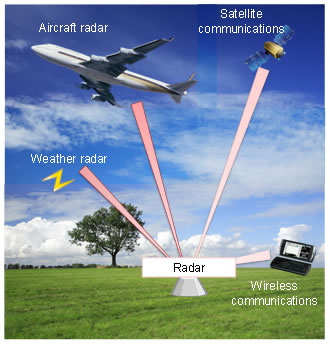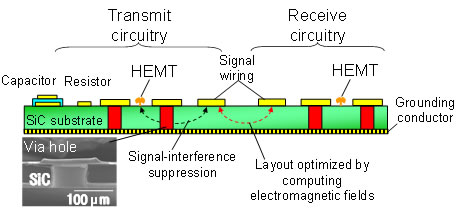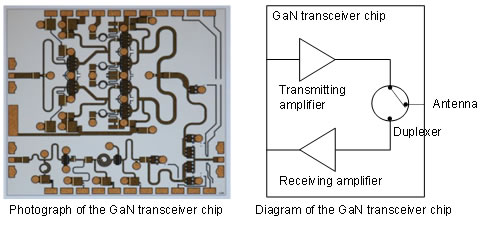Archived content
NOTE: this is an archived page and the content is likely to be out of date.
Fujitsu Develops World's First Compact, High-Output, Single-Chip 10 GHz Transceiver Using GaN HEMT
Reduces chip footprint by over 90%, enabling more compact radars and wireless communications equipment
Fujitsu Laboratories Ltd.
-
[1] Gallium nitride (GaN)
GaN-based semiconductors are wide bandgap semiconductors that feature a higher breakdown-voltage (threshold) than conventional semiconductor materials, such as silicon (Si) or gallium arsenide (GaAs).
-
[2] High electron mobility transistor (HEMT)
A field-effect transistor that utilizes the electron movement at the junction between two semiconductors with different bandgaps—as electron mobility in HEMTs is faster than that of conventional semiconductors. Fujitsu led the industry with its development of HEMT technology in 1980, and HEMTs, as a core technology underpinning the network-based society, are currently used in a wide range of core technologies for IT applications, including satellite transceivers, mobile phones, GPS-based navigations systems, and broadband wireless networking systems.
About Fujitsu
Fujitsu is the leading Japanese information and communication technology (ICT) company offering a full range of technology products, solutions and services. Over 170,000 Fujitsu people support customers in more than 100 countries. We use our experience and the power of ICT to shape the future of society with our customers. Fujitsu Limited (TSE:6702) reported consolidated revenues of 4.5 trillion yen (US$54 billion) for the fiscal year ended March 31, 2012. For more information, please see http://www.fujitsu.com.
About Fujitsu Laboratories
Founded in 1968 as a wholly owned subsidiary of Fujitsu Limited, Fujitsu Laboratories Limited is one of the premier research centers in the world. With a global network of laboratories in Japan, China, the United States and Europe, the organization conducts a wide range of basic and applied research in the areas of Next-generation Services, Computer Servers, Networks, Electronic Devices and Advanced Materials. For more information, please see: http://jp.fujitsu.com/labs/en.
Technical Contacts
Devices & Materials LaboratoriesAdvanced Devices Lab.
![]() E-mail: gan-hemt-press@ml.labs.fujitsu.com
E-mail: gan-hemt-press@ml.labs.fujitsu.com
Company:Fujitsu Laboratories Ltd.
All other company or product names mentioned herein are trademarks or registered trademarks of their respective owners. Information provided in this press release is accurate at time of publication and is subject to change without advance notice.
Date: 20 June, 2012
City: Kawasaki, Japan
Company:
Fujitsu Laboratories Ltd.,
,
,
,
,
,
,
,
,
,



